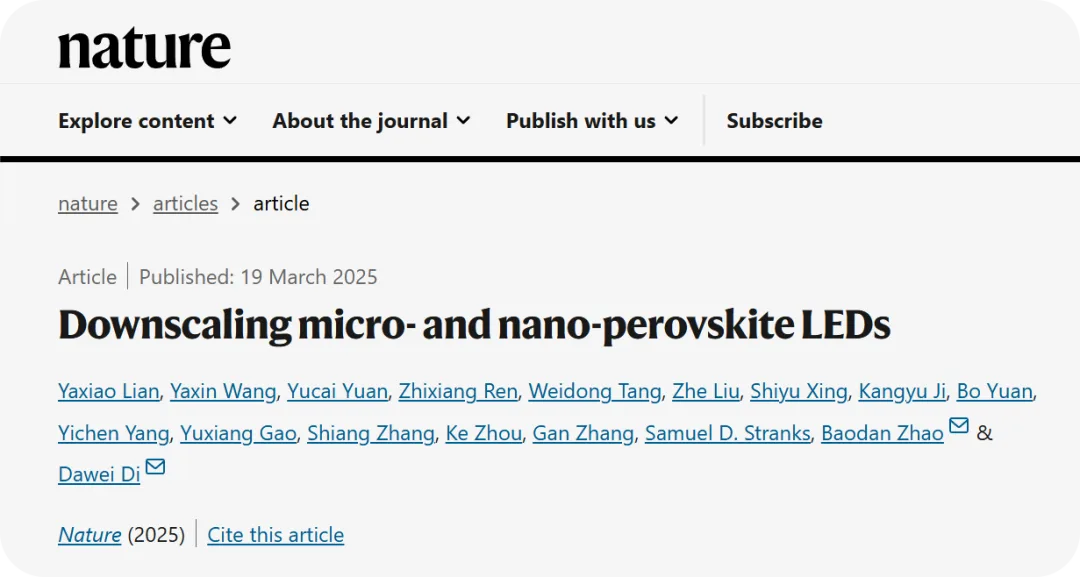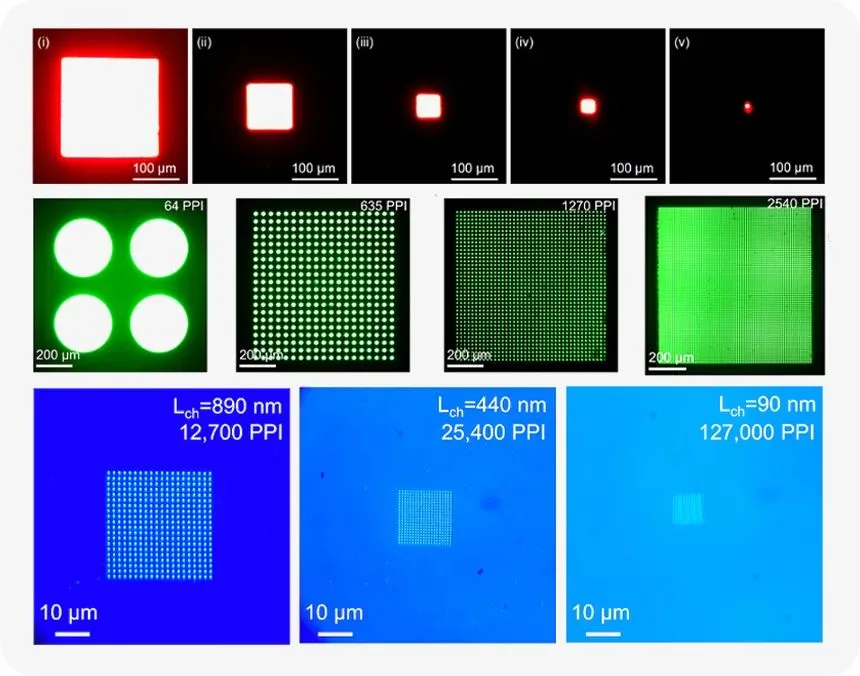Recently, a paper titled “Downscaling micro- and nano-perovskite LEDs” by the team of Professor David Xingliang Dai and Professor Baodan Zhao from Zhejiang University was published in Nature, a world-leading academic journal. The paper introduces the team’s development of extremely small LEDs based on novel perovskite semiconductors.
Using TFT display chips and array driving systems from LinkZill Technology, these LED pixel arrays demonstrated excellent luminescence performance. This also marks the first time LinkZill’s products have been featured in a main Nature journal article. Together with our partners, we are paving new possibilities for the industrialization of next-generation display technologies.

The invention of Micro-LED is considered the “ultimate technology” for displays. However, the manufacturing cost of micro-LEDs is extremely high, and their efficiency drops sharply when scaled down to about 10 micrometers or smaller, hindering their potential for large-scale commercial applications. Building on this, the team of Professor David Xingliang Dai and Professor Baodan Zhao from Zhejiang University proposed the concepts of micro-perovskite LEDs (micro-PeLEDs) and nano-perovskite LEDs (nano-PeLEDs), exploring new dimensional limits that are difficult to achieve with traditional LEDs.
The smallest nano-PeLED constructed by the team reached 90 nanometers, making it the smallest LED pixel reported to date. As a result, the research team was able to create an LED pixel array with an ultra-high resolution of 127,000 PPI, setting a new record for the highest resolution among all types of LED arrays.

To prevent perovskite materials from being exposed at electrode edges—which causes non-radiative energy loss and reduces LED efficiency—the team developed a localized contact process. Patterned windows fabricated by photolithography were introduced in an additional insulating layer to ensure the pixel areas were kept away from electrode edges. This enabled the green and near-infrared perovskite LEDs created by the team to exhibit downscaling effects only at extremely small sizes of around 180 nanometers, achieving higher efficiency than micro-LEDs based on III-V semiconductors.
By integrating these perovskite LEDs with LinkZill’s ZhiHe Display product series, the team constructed an active-matrix micro-PeLED microdisplay prototype capable of presenting complex images and videos, validating both its display performance and practical application potential.

Professor David Xingliang Dai, Zhejiang University
Exploring the downscaling effects of LEDs and breaking through their size limits is driven by curiosity-inspired academic research. At the same time, another significant aspect of this study lies in its bold attempt to advance micro-PeLED technology toward practical application. In this process, we received crucial technical support from LinkZill Technology, a tech company based in Hangzhou. LinkZill is an emerging enterprise focused on developing thin-film transistor (TFT) applications in optoelectronics and biology. Its founder, Dr. Linrun Feng, is a young entrepreneur with great vision. The TFT arrays they developed are compatible with perovskite LED processes, making them an ideal driving circuit. With LinkZill’s technical support, we successfully developed an active-matrix micro-PeLED microdisplay prototype that can already display complex images and videos. This is highly exciting, as it suggests that the bridge from academia to technology for micro-PeLEDs may already be built.
Dr. Linrun Feng, Founder of LinkZill Technology
From meeting to knowing each other, and even to appreciating Wang Xizhi’s “Preface to the Orchid Pavilion Pavilion” together, my friendship with David has lasted less than a year, yet feels as deep as if it spanned a century. David has shown me the ultimate purity of a scientist—limitless exploration driven by curiosity, and a profound humility born of crystal-clear self-awareness. I am deeply drawn to him. I am honored and delighted to see LinkZill’s TFT technology help David and Baodan’s work reach the top of *Nature*, leaving a mark of our friendship in the global academic sanctuary, representing China’s integration of industry, academia, and research. Let past achievements remain in the past. For the future, I look forward to more mutual support, more beautiful connections, and more groundbreaking wonders!

LinkZill’s TFT array display chips support various display materials such as perovskite LEDs, QLEDs, and OLEDs. When paired with back-end array driving systems, they enable the activation of images and videos.
Additionally, we offer chip and system customization services, allowing adjustments to pixel size, resolution, refresh rate, and other specifications based on client requirements, further enhancing validation outcomes.
This collaboration with Zhejiang University’s team resulting in a Nature publication not only recognizes our technical capabilities but also reaffirms that TFT technology, as an ideal supporting platform for light-emitting devices, will bring revolutionary breakthroughs to next-generation display technologies.
To date, our products have supported over 300 tech companies, universities, and research institutions, contributing to nearly 200 high-impact journal publications. These span various fields including photodetection, novel luminescent displays, health monitoring, and biomedical detection, with related research陆续 published in top-tier international journals such as Nature, Nature Electronics, Nature Nanotechnology, and Advanced Materials.
As LinkZill continues to deepen collaborations with global partners, we will further support the exploration of cutting-edge technological boundaries. We look forward to bringing innovative technologies and products to the global market, promoting common progress and development in the international academic and industrial communities.
Everyone is welcome to stay updated on our latest developments and join us in advancing interdisciplinary industrialization with TFT semiconductor technology.



